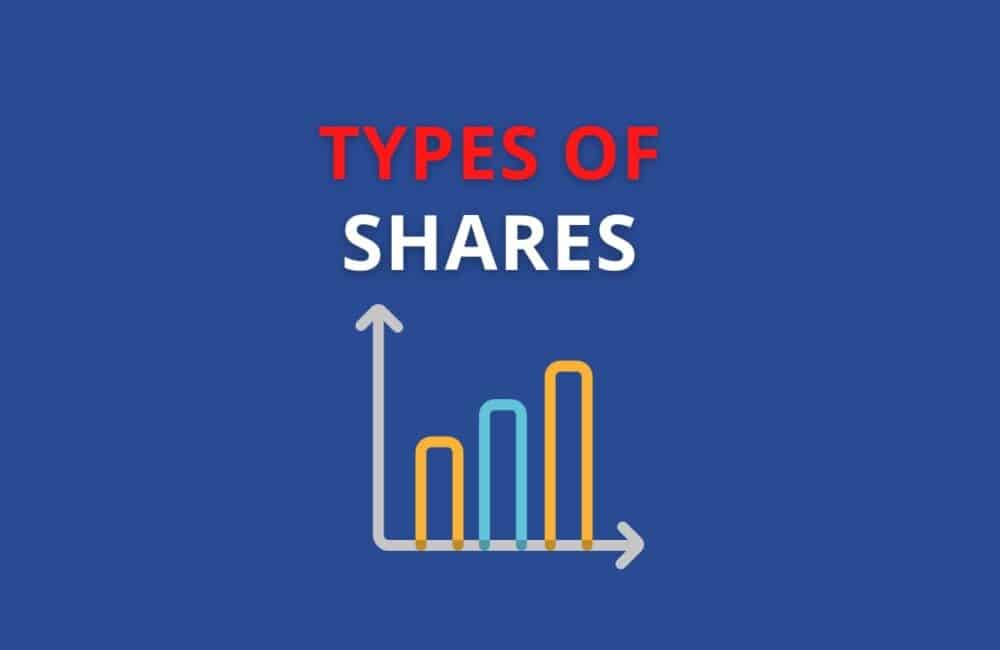In business, a share represents a shareholder’s participation in the assets of a company. Stocks represent a shareholder’s ownership stake in the company. A public limited company may issue stock to raise capital for its business. These shares also carry a variety of other rights in addition to their ownership rights. Certain types of shares confer certain rights, such as the right to receive dividends on priority, to share in the company’s profits, and to share in its losses, etc.
Dividends are a common feature of all forms of shares, which are paid out of profits.
Types Of Shares
Shares can be classified into two types –
- Ordinary shares
- Preference shares
There are several differences between both types of shares, including their respective share of profitability, voting rights, as well as the settlement of capital at the time of winding up or liquidation.
Ordinary Shares
Ordinary shares are defined as the shares of a company providing the shareholder with the right to vote at the annual meeting of the corporation and to receive dividends from its profits. Such shares are known as ordinary shares.
As far as voting rights are concerned, a single share generally entails one vote, which could be related to company policies or the election of directors. Companies may, however, modify the ratio between the number of shares and the number of votes.
The ordinary shareholder also shares in the losses that a company suffers to the extent of their stake in the company. Due to their stake in a company’s ownership and representation of its equity, equity shareholders are granted these entitlements.
In terms of types of shares, ordinary shares can be classified according to two different concepts. The first is based on definitions while the second is based on characteristics.
Also Read: What is Face Value of Share?
Ordinary Shares Classification – Definition Based
Authorized Share Capital
The authorized share capital of the company is the maximum amount of shares that the company is authorized to issue to shareholders under its constitutional documents. These shares are known as an authorized capital share.
A Memorandum of Association (MoA), indicates the amount of capital that a company can raise through the issuance of stocks. For example, if the Memorandum of Association indicates that a company is authorized to issue shares with an outstanding value of only Rs.50 crore, the company may not issue shares that exceed that amount. The MoA does not, however, preclude a company from modifying the authorized share capital subsequently.
Issued Share Capital
An issued share is a share of a corporation that has been assigned to its shareholders for their use. This type of share is known as an issued capital share. Issuance of shares is understood to be a means of raising capital by issuing securities. However, it is important to note that issued share capital simply represents the nominal value of all ordinary shares issued by the company. A company’s issued capital, for example, is Rs. 5 crores if its nominal capital is Rs. 10 and it has issued 50 lakh shares in the market.
Also Read: What is MTM in Share Market?
Subscribed Capital And Paid-up Capital
Subscribed Capital is defined as the portion of issued capital that has been sold to the public. This type of capital is known as subscribed capital. Refers to the proportion of issued capital that has been subscribed to by investors. Occasionally, investors do not purchase all of the shares that are issued by a company.
Paid-up capital is the amount of money that a company has received from its shareholders in exchange for shares of stock. This type of capital is called paid-up capital. The paid-up capital of a company is the amount of money that investors have contributed to purchase shares. As such, it directly relates to the amount of capital raised by a company through equity issuance.
Ordinary Shares Classification – Feature Based
Voting Shares And Non-voting Shares
A voting share is a share of stock that entitles you to cast a vote on matters of corporate policy. Such shares are often referred to as voting shares. According to its name, these voting shares entitle their holders to vote in matters relating to the company’s policies or election of directors. Ordinary shares are normally voting shares.
Non-voting shares are shares in the capital of a company belonging to a class that does not have the right to vote. These shares are often referred to as non-voting shares. If the shares are non-voting, they may have differential voting rights or no voting rights at all.
Sweat Equity Shares
Sweat equity refers to non-monetary contributions made to a company by its stakeholders in the form of labor and time rather than monetary contributions. These contributions are rewarded in the form of sweat equity shares. The shares are exchanged for labor and time as opposed to a monetary amount. This type of share is commonly known as sweat equity shares. Shares of a company can be issued as compensation to its employees and directors, usually when they perform well. By offering sweat equity shares to employees, companies retain efficient employees.
Also Read: Difference Between Shares and Debentures
Right Shares
Right shares are shares whose issuance occurs to existing shareholders after the original issue of shares but which have an inherent right to be subscribed to by existing shareholders in proportion to their holdings. Such shares are often referred to as right shares. This is one of the many types of stock that companies issue to their existing shareholders. The company offers existing shareholders the opportunity to purchase such shares before the shares are made available to the general public.
Bonus Shares
Bonus shares are shares that are given to existing shareholders by the company free of charge, as fully paid shares. These shares are commonly referred to as Bonus shares. Dividends are often paid in the form of bonus shares rather than cash. Existing shareholders therefore only have the right to receive bonus shares. A portion of retained earnings can also be converted into equity shares by organizations.
Preference Shares
Preference shares, also referred to as preferred stock, are shares of a company’s stock with dividends that are paid to shareholders before dividends on common stock are distributed. Such shares are known as preference shares.
Shares with preference rights are entitled to special treatment, including dividend receipts and capital reimbursements when an organization is winding down.
Additionally, preference shareholders are entitled to a guaranteed fixed dividend, while ordinary shareholders are not. Therefore, investors seeking low-risk investments may choose to invest in preference shares of a company.
Preference shareholders, however, typically are not entitled to share in an organization’s profits beyond their fixed entitlement. Thus, if a company raises its dividend rate following its net income, preference shareholders will not be able to benefit from such a raise, only ordinary shareholders will. Also, preference shares have no voting rights. Due to these factors, preference shares are not typically chosen by investors.
Also Read: When is Intraday Profit Credited?
Preference Shares Classification
Redeemable And Irredeemable Preference Shares
A redeemable share can be purchased by the issuing corporation at a predetermined date or following a specified event. This type of share is known as a redeemable share. A redeemable share is one in which the issuing company and the shareholders agree that the company can repurchase or redeem those shares at a later time, either after the expiry of a certain period or at a future date. A redeemable share can either be exercised by the shareholder or by the organization, depending on who can exercise the buyback provision.
An irredeemable preference share is a preference share that can only be redeemed upon the liquidation of the corporation. Such shares are referred to as irredeemable shares. Irredeemable shares are therefore the exact opposite of redeemable shares.
Convertible And Non-convertible Preference Shares
Convertible preference shares are corporate fixed-income instruments in which the investor has the option to convert them into a predetermined number of shares of the company’s common stock at a predetermined time. These shares are called convertible preference shares. In addition to this, types of shares can be classified based on whether they are convertible or not.
Non-convertible preference shares, shares are not convertible into equity shares but are only redeemable for preference shares. Such shares are referred to as non-convertible preference shares.
Participating And Non-participating Preference Shares
Participating preferred shares are preferred share that entitles their holders to dividends equal to the customarily specified rate at which preferred dividends are paid to preferred shareholders, along with an additional dividend contingent on certain criteria. Such type of share is known as Participating preference shares. As soon as a company distributes dividends to its ordinary shareholders, holders of participating preference shares are entitled to share in the profits. Consequently, when a company’s net income is substantial, these shareholders will receive a portion of such profits.
Non-Participating Preferred Shares are the shares that enable the shareholders to have preferential rights or high priority. Such events occur during the liquidation of the company or dividend payments. These shares are referred to as non-participating preferred shares. In contrast, holders of non-participating shares are entitled only to a fixed dividend payment.
Cumulative And Non-cumulative Preference Shares
A cumulative preference share is a regular preference share with an additional benefit. There is an additional benefit here, as holders of these shares will be entitled to dividends even if the company issuing the shares missed out on paying them previously. These shares are known as cumulative preference shares. As a cumulative stock, a company’s dividend entitlement for preference shares is carried forward to the following year if it does not provide dividends in a particular year.
A non-cumulative preference share provides each shareholder with a fixed dividend amount based upon the company’s net profits each year. These shares are referred to as non-cumulative preference shares. In contrast, when a company does not pay dividends in a particular year, the dividend amount is not carried forward.
Recommended:
What is Trade to Trade Segment?
What is Dabba Trading & How Dabba Trading Works?
Difference Between Demat Account and Trading Account
Frequently Asked Questions
What Is The Best Type Of Share To Purchase?
Common stock prices are more volatile than preferred stock prices, so shares on preferred stock are less liable to lose value, but they are also less prone to gaining value. The preferred stock market is best suited to investors who place a high value on income over long-term growth.
How Is The Share Used?
Investors exchange capital for shares of a corporation or financial asset, representing equity ownership. Investors may receive voting rights and dividends as a result of purchasing common shares.
What Are The Various Categories Of Shareholders?
There are two types of shareholders in a company, the common shareholder and the preferred shareholder. Common stockholders are the owners of the common stock of a corporation.
What Are The Differences Between Shares And Debentures?
A share represents the company’s capital, while a debt represents the company’s debt. A share represents the ownership of the company by its shareholders. Debentures, on the other hand, represent a debt owed by the company. Dividends earned on shares are referred to as dividend income, while interest earned on debt instruments is referred to as interest income



